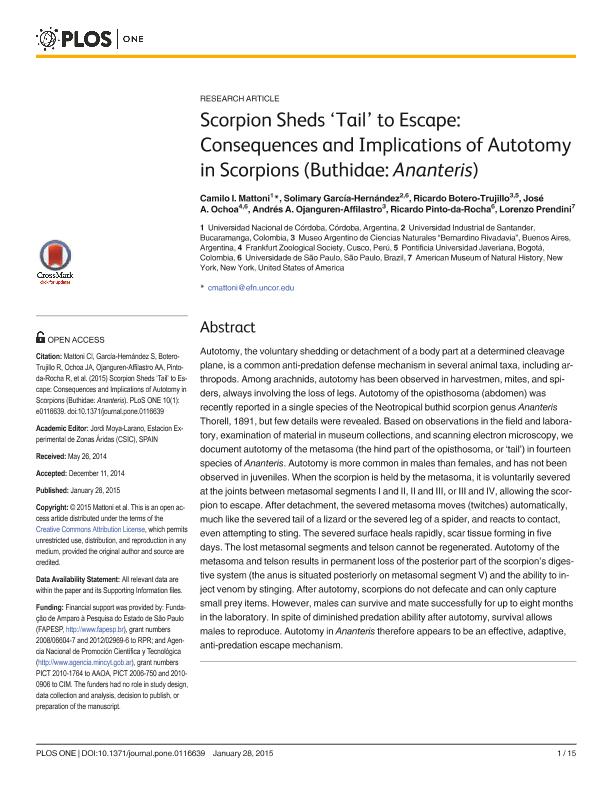Mostrar el registro sencillo del ítem
dc.contributor.author
Mattoni, Camilo Ivan

dc.contributor.author
García Hernández, Solimary
dc.contributor.author
Botero Trujillo, Ricardo

dc.contributor.author
Ochoa, José A.
dc.contributor.author
Ojanguren Affilastro, Andres Alejandro

dc.contributor.author
Pinto da rocha, Ricardo
dc.contributor.author
Prendini, Lorenzo
dc.date.available
2016-11-03T19:10:20Z
dc.date.issued
2015-01
dc.identifier.citation
Mattoni, Camilo Ivan; García Hernández, Solimary; Botero Trujillo, Ricardo; Ochoa, José A.; Ojanguren Affilastro, Andres Alejandro; et al.; Scorpion sheds 'tail' to escape: consequences and implications of autotomy in scorpions (Buthidae: Ananteris); Public Library Of Science; Plos One; 10; 1; 1-2015; 1-15
dc.identifier.issn
1932-6203
dc.identifier.uri
http://hdl.handle.net/11336/7944
dc.description.abstract
Autotomy, the voluntary shedding or detachment of a body part at a determined cleavage plane, is a common anti-predation defense mechanism in several animal taxa, including arthropods. Among arachnids, autotomy has been observed in harvestmen, mites, and spiders, always involving the loss of legs. Autotomy of the opisthosoma (abdomen) was recently reported in a single species of the Neotropical buthid scorpion genus Ananteris Thorell, 1891, but few details were revealed. Based on observations in the field and laboratory, examination of material in museum collections, and scanning electron microscopy, we document autotomy of the metasoma (the hind part of the opisthosoma, or ?tail?) in fourteen species of Ananteris. Autotomy is more common in males than females, and has not been observed in juveniles. When the scorpion is held by the metasoma, it is voluntarily severed at the joints between metasomal segments I and II, II and III, or III and IV, allowing the scorpion to escape. After detachment, the severed metasoma moves (twitches) automatically, much like the severed tail of a lizard or the severed leg of a spider, and reacts to contact, even attempting to sting. The severed surface heals rapidly, scar tissue forming in five days. The lost metasomal segments and telson cannot be regenerated. Autotomy of the metasoma and telson results in permanent loss of the posterior part of the scorpion?s digestive system (the anus is situated posteriorly on metasomal segment V) and the ability to inject venom by stinging. After autotomy, scorpions do not defecate and can only capture small prey items. However, males can survive and mate successfully for up to eight months in the laboratory. In spite of diminished predation ability after autotomy, survival allows males to reproduce. Autotomy in Ananteris therefore appears to be an effective, adaptive, anti-predation escape mechanism.
dc.format
application/pdf
dc.language.iso
eng
dc.publisher
Public Library Of Science

dc.rights
info:eu-repo/semantics/openAccess
dc.rights.uri
https://creativecommons.org/licenses/by/2.5/ar/
dc.subject
Scorpiones
dc.subject
Ananteris
dc.subject
Autotomy
dc.subject.classification
Zoología, Ornitología, Entomología, Etología

dc.subject.classification
Ciencias Biológicas

dc.subject.classification
CIENCIAS NATURALES Y EXACTAS

dc.title
Scorpion sheds 'tail' to escape: consequences and implications of autotomy in scorpions (Buthidae: Ananteris)
dc.type
info:eu-repo/semantics/article
dc.type
info:ar-repo/semantics/artículo
dc.type
info:eu-repo/semantics/publishedVersion
dc.date.updated
2016-11-02T18:14:41Z
dc.journal.volume
10
dc.journal.number
1
dc.journal.pagination
1-15
dc.journal.pais
Estados Unidos

dc.journal.ciudad
San Francisco
dc.description.fil
Fil: Mattoni, Camilo Ivan. Universidad Nacional de Córdoba; Argentina
dc.description.fil
Fil: García Hernández, Solimary. Universidad Industrial Santander; Colombia. Universidade de Sao Paulo; Brasil
dc.description.fil
Fil: Botero Trujillo, Ricardo. Consejo Nacional de Investigaciones Científicas y Técnicas. Oficina de Coordinación Administrativa Parque Centenario. Museo Argentino de Ciencias Naturales; Argentina. Pontificia Universidad Javeriana; Colombia
dc.description.fil
Fil: Ochoa, José A.. Frankfurt Zoological Society; Perú. Universidade de Sao Paulo; Brasil
dc.description.fil
Fil: Ojanguren Affilastro, Andres Alejandro. Consejo Nacional de Investigaciones Científicas y Técnicas. Oficina de Coordinación Administrativa Parque Centenario. Museo Argentino de Ciencias Naturales; Argentina
dc.description.fil
Fil: Pinto da rocha, Ricardo. Universidade de Sao Paulo; Brasil
dc.description.fil
Fil: Prendini, Lorenzo. American Museum Of Natural History; Estados Unidos
dc.journal.title
Plos One

dc.relation.alternativeid
info:eu-repo/semantics/altIdentifier/url/http://journals.plos.org/plosone/article?id=10.1371/journal.pone.0116639
dc.relation.alternativeid
info:eu-repo/semantics/altIdentifier/doi/http://dx.doi.org/10.1371/journal.pone.0116639
dc.relation.alternativeid
info:eu-repo/semantics/altIdentifier/url/https://www.ncbi.nlm.nih.gov/pmc/articles/pmid/25629529/
Archivos asociados
